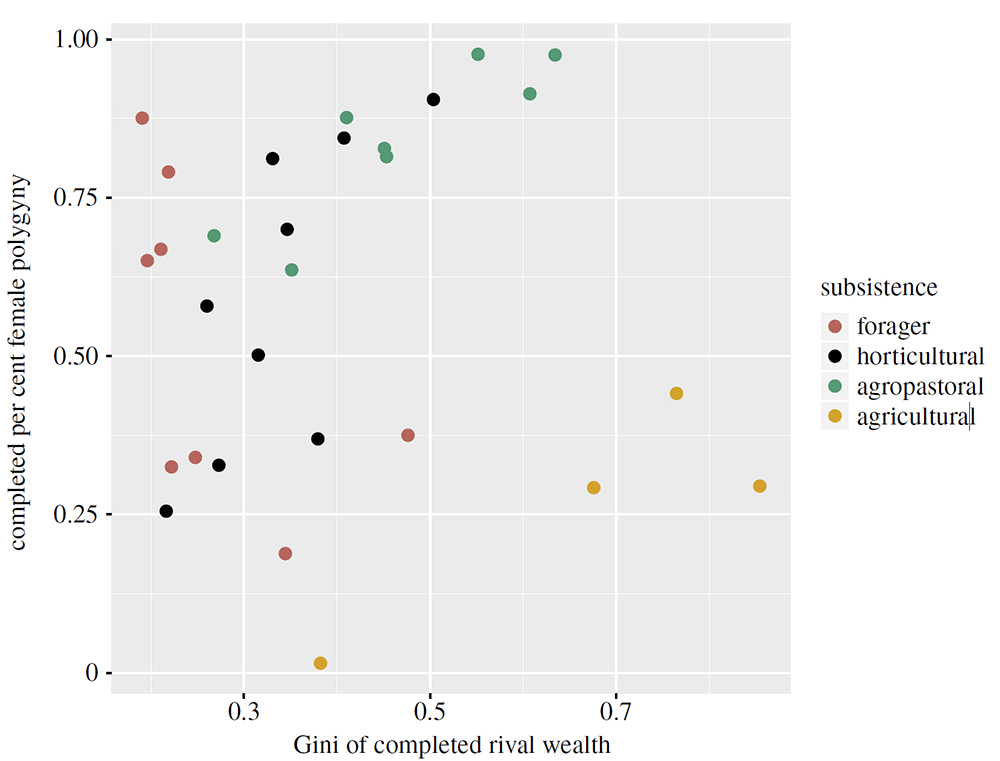Open access Greater wealth inequality, less polygyny: rethinking the polygyny threshold model by Ross et al. Journal of the Royal Society Interface (2018).
Interesting excerpts, from the discussion (emphasis mine):
We use cross-cultural data and a new mutual mate choice model to propose a resolution to the polygyny paradox. Following Oh et al. [17], we extend the standard polygyny threshold model to a mutual mate choice model that accounts for both female supply to, and male demand for, polygynous matchings, in the light of the importance of, and inequality in, rival and non-rival forms of wealth. The empirical results presented in figures 5 and 6 demonstrate two phenomena that are jointly sufficient to generate a transition to more frequent monogamy among populations with a co-occurring transition to a more unequal, highly stratified, class-based social structure. In such populations, fewer men can cross the wealth threshold required to obtain a second wife, and those who do may be fabulously wealthy, but—because of diminishing marginal fitness returns to increasing number of marriages—do not acquire wives in full proportion to their capacity to support them with rival wealth. Together, these effects reduce the population-level fraction of wives in polygynous marriages.
Our model demonstrates that a low population-level frequency of polygyny will be an equilibrium outcome among fitness maximizing males and females in a society characterized by a large class of wealth-poor peasants and a small class of exceptionally wealthy elite. Our mutual mate choice model thus provides an empirically plausible resolution to the polygyny paradox and the transition to monogamy which co-occurred with the rise of highly unequal agricultural populations.

The reasons for this decrease in marginal fitness returns are explained as either a) a potential missing of important rival forms of wealth in the statistical model, or b) one or more of the following reasons:
- [A] male’s time and attention are rival inputs to his own fitness (…) A single rich man will have to defend his 10 wives from nine unmarried men on average.”As the wealth ratio grows even more skewed, this situation could become increasingly difficult to manage (e.g. requiring the use of eunochs to defend harems [74]).
- A related possibility is that a growing number of unmarried men could socially censure wealthy polygynous males, imposing costs on them that reduce male demand for and/or female supply to polygynous marriage [23,24]. (…)
- A third possibility is that sexually transmitted infection (STI) burden [22,75] could diminish returns to polygyny, if polygyny enhances infection rates [76,77]. (…)
- Finally, impediments to cooperation or even outright conflict among co-wives can be greater as the number of wives increases. Interference competition among co-wives could impose significant fitness costs in settings where effective child rearing benefits from cooperation [79,80].(…)

I have previously argued against some reasons traditionally given to explain the replacement of native male populations after migrations (i.e. polygyny, slavery, targeted male extermination, etc.), because I believe that a gradual successful expansion of patrilineal clans over some generations based on wealth alone is enough to explain the obvious Y-DNA bottlenecks that happened in many different prehistoric and historic cultures (especially among steppe pastoralists, including Indo-Europeans).
I realize that I haven’t really used any study to support my opinion, though, and data from modern and ancient pastoralists from different regions seem to contradict it, so maybe ancient DNA can show that Indo-Europeans had often children with more than one woman at the same time. I don’t remember seeing that kind of information in supplementary materials to date. From memory I can think of maybe two or three examples of agnate siblings published, but I doubt the archaeological age estimation (based on simple observation of skeletal remains) combined with radiocarbon age (usually given with broad CI) could be enough to prove a similar age of conception. Maybe a case of many siblings clearly of the same age and from many different mothers in the same burial could be a strong proof of this…
I recently read that theoretical models are actually trusted by no one except for the researchers who propose them, and experimental data are trusted by everyone except for the researchers who worked with them. I cannot agree more. However, we lack information about this question (as far as I know), so we may have to rely on indirect estimations, like the kind of models presented in the paper (or the one proposed for Post-Neolithic Y-chromosome bottlenecks).
The Late Proto-Indo-European word for bride comes from a root meaning ‘drive, lead’, hence literally ‘deportation’, so the bride was transferred from her father’s family to her husband’s house. Marriage was certainly an asymmetrical contract for its members, and the reconstructible word for ‘dowry’ further supports the weaker position of the wife in it. Also, ancient marriage could differ from a family agreement, because marriage by elopement, bride kidnapping or hostage was probably common (more or less socially regulated) for people belonging the same culture. Apart from this, I don’t know about reconstructed linguistic data pointing to polygyny, and I doubt archaeological data alone – without genetics – can help.
Related
- Post-Neolithic Y-chromosome bottleneck explained by cultural hitchhiking and competition between patrilineal clans
- David Reich on social inequality and Yamna expansion with few Y-DNA subclades
- Haplogroup is not language, but R1b-L23 expansion was associated with Proto-Indo-Europeans
- Lazaridis’ evolutionary history of human populations in Europe
- Ancient nomadic tribes of the Mongolian steppe dominated by a single paternal lineage
- Bantu distinguished from Khoe by uniparental markers, not genome-wide autosomal admixture
- Reconstruction of Y-DNA phylogeny helps also reconstruct Tibeto-Burman expansion
- Ancient Di-Qiang people show early links with Han Chinese
- The Indo-European demic diffusion model, and the “R1b – Indo-European” association